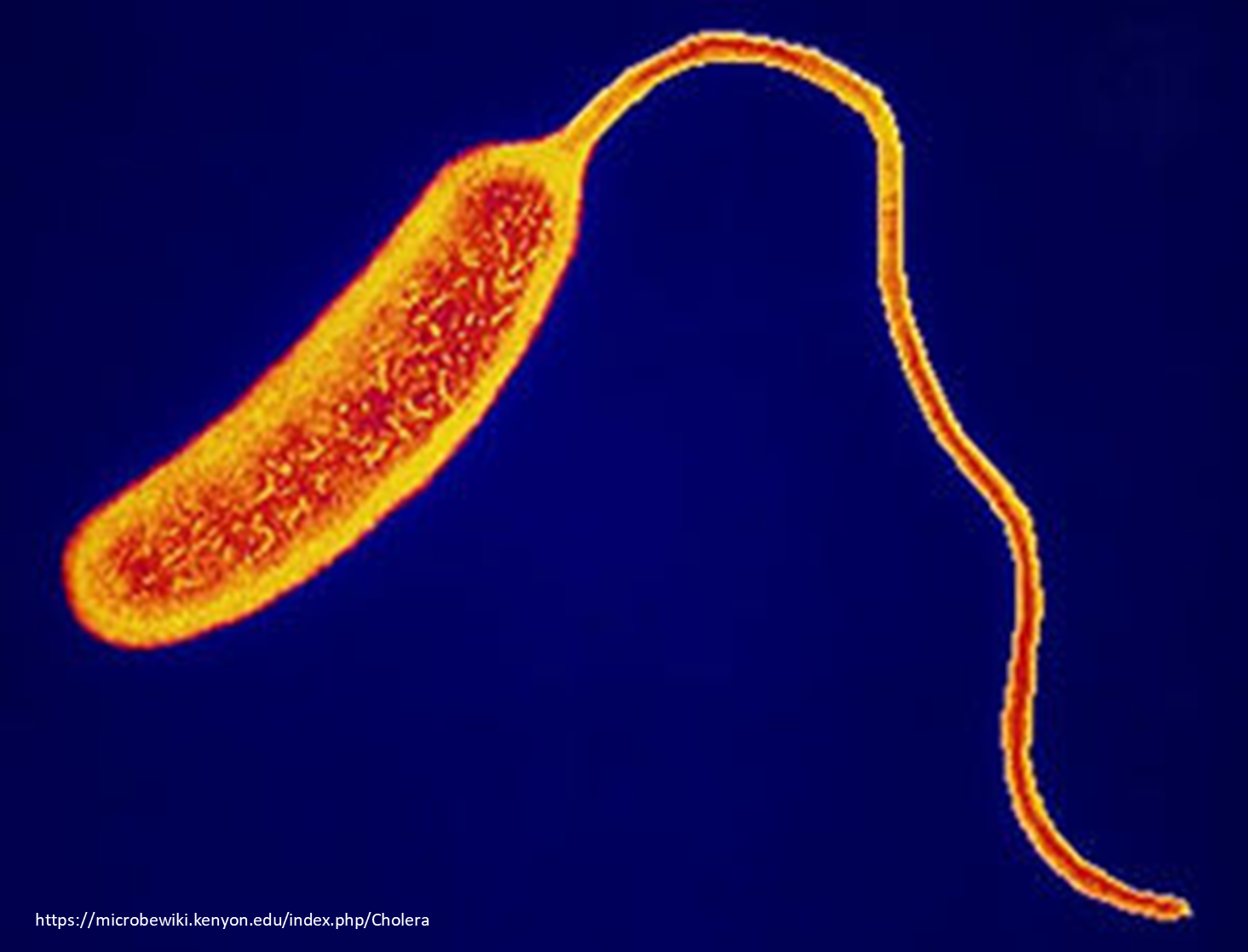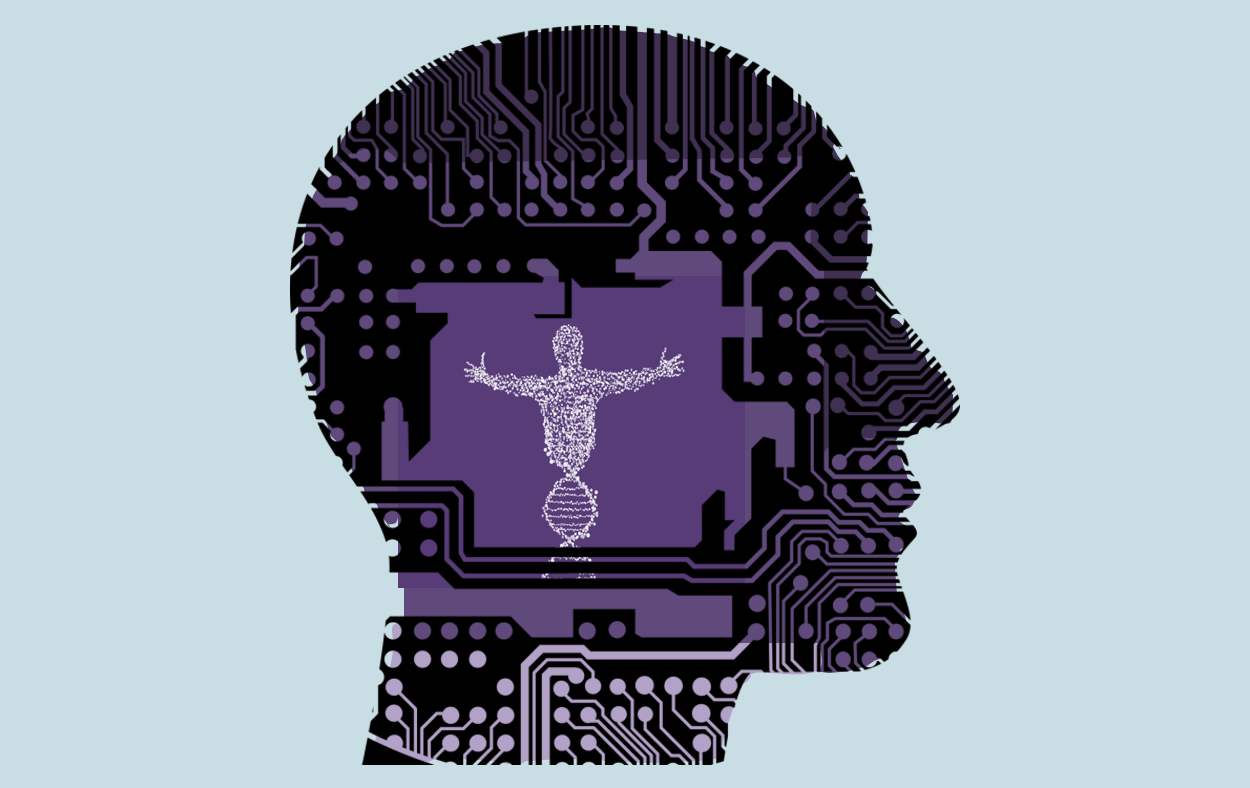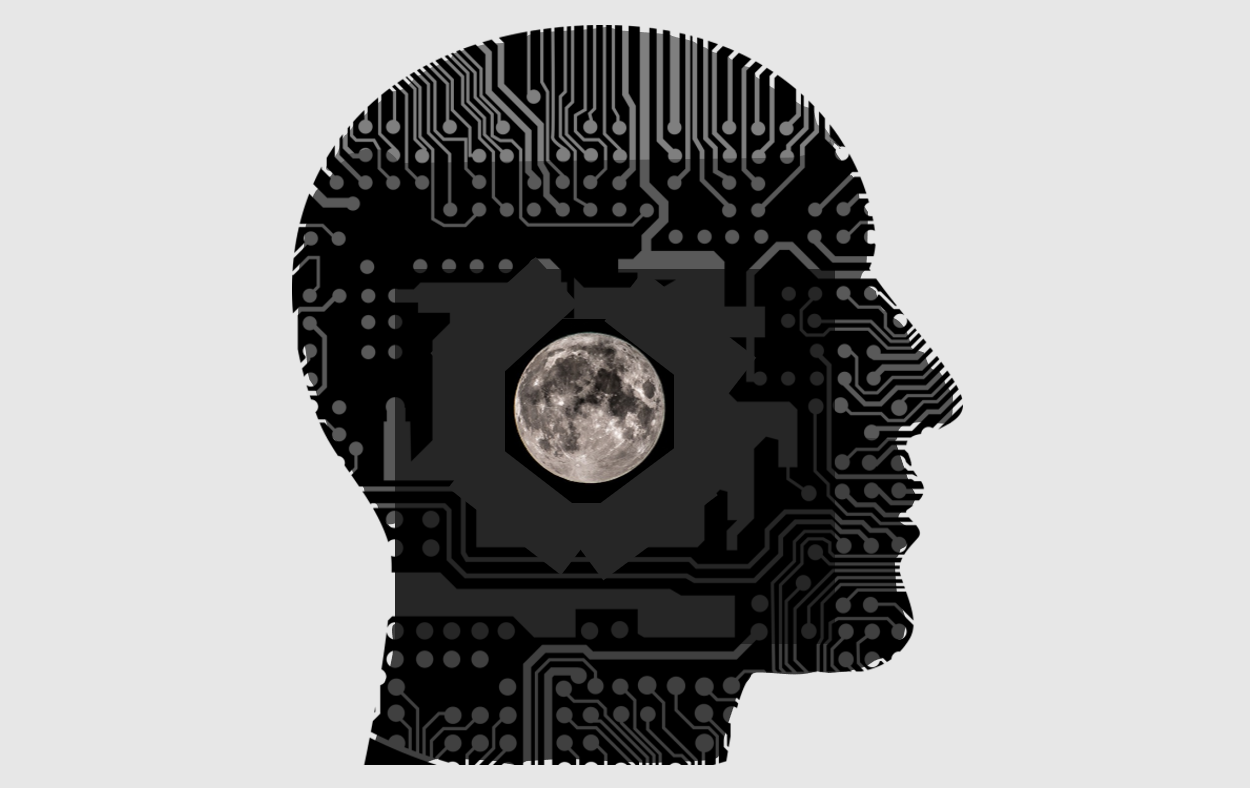For example, you may have heard of Vibrio cholerae, the bacterium that causes cholera, a diarrheal disease.

A cholera bacterium. Cute little guy, no?
Cholera kills you via dehydration, but before you go, you will expel vast amounts of liquid poop. Cholera killed at least 143 million people per year during a 26-year period. But what about a viral disease that causes diarrhea? Perhaps you have heard of Norovirus, a virus that spreads when you ingest fecal matter – most people hear about outbreaks on cruise ships. Yeah, I mean that you get Norovirus by eating food or drinking water contaminated with infected poo.

Definitely not.
Many of these kinds of pathogens are spread in contaminated food or water. In fact, the World Health Organization estimates that in developing nations, more than 50% of the people who live in urban areas are eventually affected by diseases related to unsafe drinking water. Poor sanitation, unsafe drinking water, and a warm moist environment, will make many of these buggers super happy and any humans that encounter them super… likely to poop.
Enter climate change. As the planet warms, we can expect that the warm parts of the planet are going to expand outward from the equator, meaning that the climate that our microbe friends enjoy is going to be moving more northerly and southerly. If you were a pathogenic microbe, and you were suddenly able to migrate into new areas – you know, find new stompin’ grounds – wouldn’t you? Especially if your old territory became much too hot for you to survive there. Diseases, like cholera and malaria, that typically live in warm, developing nations could be moving into Europe and the lower part of the United States. However, that doesn’t mean we will all die of dysentery, like in The Oregon Trail.

Oh no!
One important reason we don’t see these diseases in industrialized countries is because we have modern water treatment and sanitation facilities. Industrialized nations also have treatment plans for critters that carry diseases, like ticks or mosquitos.

Moving day.
Water treatment doesn’t always get every pathogenic microbe, but our climate is inhospitable to most of them which helps keep them under control. For now. If that isn’t enough to save us, we have modern medicine. Antibiotics and anti-viral medicines that may not be readily available in poorer nations, but they can be prescribed by your doctor in industrialized nations.
Now let’s head to the icy north. The second of those potential new climate change/pathogenic microbe threats I mentioned at the beginning is the possibility of emerging zombie pathogens. Pathogenic microbes that were frozen in soil and water (or in long-dead carcasses) thousands of years ago could become viable again if the conditions are right. Temperatures are warming at an alarming rate, from one perspective, but from a microbe’s perspective, the temperatures are warming just slowly enough for a gentle thaw. That’s exactly what most pathogenic buggers need to become viable again once exposed to the environment. When an infected human or animal dies and is buried in a cold climate, the ground freezes and layers of sediments, snow and ice are deposited on top of the grave. As the climate warms, the ice and permafrost thaw, releasing any microbes that survived.
In an article from National Public Radio, Zac Peterson described his research, which involved working with perfectly frozen seal carcasses in northern Alaska. The seals thawed into a gooey mess and Zac spent time kneeling in that goo. The knee that was in contact with the goo became red and inflamed. He had contracted a case of seal finger disease, a bacterial infection known to infect seal hunters. Zac had only been working with 800 year old, previously frozen seals. There have also been cases of frozen reindeer dying from anthrax in Siberia and becoming buried in the permafrost. 70 years later, the ice thawed during a heat wave in 2016. The infected reindeer were also able to thaw, decompose, and release the Anthrax spores into the environment. Lot’s of people got sick and one young boy died from the infection.
It sounds pretty dire, but don’t worry! The wonders of modern science and medicine will save us again! Or at least they should. Modern drugs and medical techniques should be able to contain any of pathogens that are viable. Couple that with good hygiene and modern water and sanitation facilities and those nasty buggers don’t stand a chance! Unless the emerging pathogen is something we don’t have an available vaccine or a current treatment for….

Variola Virus – The cause of smallpox
For example, one pathogen known to be in the Siberian tundra is smallpox. Smallpox is caused by the highly contagious variola virus. It hasn’t infected a human since 1979, when the World Health Organization listed it as an eradiated disease. There is worry that, should a viable variola virus find its way from its thawing grave into a warm host, we may not have any defense against it at first. We have not needed to vaccinate people against smallpox in decades, so young populations in many parts of the world don’t have any immunity. People still die from the flu and we distribute vaccines for that virus. If smallpox found its way into a human host, millions of people could die before we are able to get enough people vaccinated to slow the spread.
The possibility of disease-causing microbes migrating into new territory or emerging from their graves in the frozen tundra may sound like a premise of a new outbreak movie, but given that the probable (and currently observable) effects of climate change are dramatic enough on their own, this new problem is sort of like throwing a diseased match on a burning planet. There is cause for concern, but we also have science and human ingenuity on our side. And since we know the threat, there is yet time to defeat it!
References
Climate change and infectious diseases. (n.d.). Retrieved January 30, 2018, from http://www.who.int/globalchange/climate/summary/en/index5.html
Doucleff, M. (2018, January 24). Are There Zombie Viruses In The Thawing Permafrost? Retrieved January 30, 2018, from https://www.npr.org/sections/goatsandsoda/2018/01/24/575974220/are-there-zombie-viruses-in-the-thawing-permafrost
Frequently asked questions and answers on smallpox. (n.d.). Retrieved February 22, 2018, from http://www.who.int/csr/disease/smallpox/faq/en/
Meyer, R. (2017, November 06). The Zombie Diseases of Climate Change. Retrieved January 30, 2018, from https://www.theatlantic.com/science/archive/2017/11/the-zombie-diseases-of-climate-change/544274/
University of Liverpool. (2017, August 2). Europe’s most dangerous pathogens: Climate change increasing risks. ScienceDaily. Retrieved January 30, 2018 from www.sciencedaily.com/releases/2017/08/170802082915.htm
Unsafe drinking-water, sanitation and waste management. (n.d.). Retrieved January 31, 2018, from http://www.who.int/sustainable-development/cities/health-risks/water-sanitation/en/
Deep in the Gombe National Park in Tanzania two famous primatologists, Richard Wrangham from Harvard University and Toshisada Nishida from Kyoto University, noticed an unusual dietary pattern among the local chimpanzees. The animals would dine on leaves of a plant from the daisy family called Aspilia. Instead of chewing on the leaves, the chimpanzees would put the leaves under their tongues for a stretch of time and then swallow the entire leaves. The chimps would frown while holding the leaves under their tongues for a good reason – Aspilia is known for its bitter taste. This means that the chimps were not eating these leaves because they tasted good but for another unknown reason that intrigued the scientists.
Fascinated by this observation, Drs. Wragham and Nishida sent samples of the Aspilia plant to a chemist, Eloy Rodriquez at the University of California in Irvine. After a thorough biochemical analysis, Dr. Rodriquez identified an abundant phytochemical in those leaves called Thiarubrine A, which acts as a potent antibacterial and antiparasitic agent. The chimpanzees consumed just enough of Thiarubrine A to kill up to 80% of parasites in their intestines.Continue reading…
Q: Are humans still evolving? B.N. Bernalillo, NM
This is a fantastic question, B.N! A solid argument can be made that humans are no longer evolving because of our advanced healthcare and medicine. Sir David Attenburough, who has done more for science then UYBFS ever will, and has been knighted for his efforts, has suggested that he thinks humans are no longer evolving based on this reasoning, saying:
“We stopped natural selection as soon as we started being able to rear 95–99 per cent of our babies that are born.”
Say a child is stricken with juvenile diabetes on his 10th birthday. Prior to the invention of modern medicine, this was a death sentence – the child would have died from hyperglycemia and diabetic ketoacidosis within a short period of time, effectively eliminating his genes from the population. However, scientists were able to determine that a loss of insulin production in the pancreas is the cause of this form of diabetes, and since 1922, insulin (first from animals, now produced in bacteria) has been available to treat these children. Today, while the effects of juvenile diabetes can still be quite severe, if the child can maintain his blood glucose levels appropriately, he or she can expect to live a relatively normal life, certainly one that will be long enough to reproduce if that is their desire.

So in this case, science and modern medicine has enabled the spread of genes responsible for (or predisposing people to) juvenile diabetes. The successful treatment of any life-threatening childhood disease with a genetic component (cancer, cystic fibrosis, severe asthma) will have the same effect. On top of this, our ability to successfully treat or prevent potentially deadly infectious diseases in children (measles, rubella, pneumonia, diphtheria, etc) will, in theory, lead to an increased number of people who are more susceptible to these diseases over time.
 The task of educating others on the benefits and potential risks of GMO food is made extremely difficult by these inherent controversies of the subject. As scientists and science advocates wrestle with this difficult task, ads such as the Stonyfield Farms spot shown above only serve to confuse the issue further.
The task of educating others on the benefits and potential risks of GMO food is made extremely difficult by these inherent controversies of the subject. As scientists and science advocates wrestle with this difficult task, ads such as the Stonyfield Farms spot shown above only serve to confuse the issue further.
This ad cynically uses children to deliver a decidedly anti-GMO message, labeling GMOs “monstrous”, and bringing up the “fish tomato,” a commonly misunderstood target of anti-GMO crusaders. The text overlay urges the viewer to “avoid GMOs” and “join the organic revolution”.
This type of misleading ad only fuels distrust of GMOs, with vague suggestions that they are “bad.” Using children makes it even worse. It is irresponsible to teach children that GMOs are “monstrous.” The fish tomato reference is particularly biased. Not only were these tomatoes never sold or eaten by a single person, there are currently no commercially available GMO tomatoes at all, and Stonyfield does not make a tomato yogurt as far as we know.

To make matters worse, after several science advocates cried foul, Stonyfield doubled-down by calling their critics “trolls”. In their statement (read it here), they did back off the “GMOs are bad” message, saying, “We do not believe that eating GMOs has been proven harmful to your health.” However, they are back to demonizing GMOs a few sentences later:
“The majority of GMO crops used by farmers today require the use of toxic herbicides. The use of glyphosate, which has been categorized as a probable carcinogen by the World Health Organization, has increased nearly 15-fold since so-called “Roundup Ready,” genetically engineered glyphosate-tolerant crops were introduced in 1996.”
This is statement is highly misleading. GMO crops do not require the use of roundup any more than regular crops, though it is used often to control weeds in the vicinity of genetically-modified “round-up ready” crops. Also ,the World Health Organization (WHO) has not classified glyphosate (the active ingredient in Roundup) as a carcinogen. This was done by the International Agency for Research on Cancer (IRAC). While IRAC is part of the WHO, the WHO disagrees, and classifies glyphosate as “unlikely to be a human carcinogen”. Worst of all, they label glyphosate as “toxic” which in this context has no meaning – toxic to what, and at what dose?
Stonyfield is also strongly implying that they do not feed their cows crops which were treated with pesticides. This is also false. Organic farming allows the use of certain pesticides, including the spraying of Bt toxin, which is the insecticide engineered into many GMO crops. It is likely that cows eating organic feed are exposed to higher levels of Bt pesticide than those that eat non-organic feed. That’s not to say that organic yogurt isn’t safe – it is, and so is non-organic yogurt.
The Stonyfield ad also includes a clear promotion of labeling GMO foods. The CEO and co-founder of Stonyfields, Gary Hirshberg, is also the chairman of Just Label It, a group which promotes the labeling of GMO foods. The labeling of GMO foods seems like a worthy conversation to have, but the promotion of a pro-labeling viewpoint by a company which will clearly benefit from such regulations, in an ad featuring children seems less like a sincere attempt to make a positive change in the world, and more like an example of corporate greed.
Standing up for science by countering misleading ads is not trolling, it’s science advocacy, and selling yogurt by exploiting people’s fears is shameful.

It seems like an accepted fact that a full moon makes kids “hyper” or people behave in a crazy way. Is there any truth to this, or is it just an old wives tale? – BH, Watertown, ME
Thanks for the question, BH! This is one of those “common knowledge” beliefs that seems to be everywhere. About 45% of people actually think this is true, which is in line with about 50% of Americans that think astrology is a science. This should make us all sad, because astrology is not a science and more people believe in astrology today than in 2004.
 As for the full moon and behavior, this was a big enough question on peoples mind that several groups of scientists actually ran studies to see if there really was an effect on behavior. Universally, they found that there is none, though there was a very small decrease in the amount of sleep that children got during a full moon, which may be related to all that moonlight coming into their window, or to their parents repeatedly telling them that they were “hyper” because of the moon.
As for the full moon and behavior, this was a big enough question on peoples mind that several groups of scientists actually ran studies to see if there really was an effect on behavior. Universally, they found that there is none, though there was a very small decrease in the amount of sleep that children got during a full moon, which may be related to all that moonlight coming into their window, or to their parents repeatedly telling them that they were “hyper” because of the moon.
Exactly why people believe this is a bit of a mystery. Certainly, it has been around for a long time – this is where the words “lunacy” and “lunatic” comes from – from the Latin lunaticus, which referred to madness or epilepsy because people thought the moon caused these effects. It could be that this is just a relic of the past before electricity when nights with a bright moon in the sky would have allowed for much more activity than dark moonless nights, or maybe just kept people from getting a good night’s sleep.
 Many people have anecdotally suggested that the full moon increases the rates of crimes, accidents, suicides, or trips to the emergency rooms. Scientists have studied these links as well, and there is no consistent effect of the phase of the moon on any of them. The same is true for animal behavior.
Many people have anecdotally suggested that the full moon increases the rates of crimes, accidents, suicides, or trips to the emergency rooms. Scientists have studied these links as well, and there is no consistent effect of the phase of the moon on any of them. The same is true for animal behavior.
Others think that the behavioral effects might be related to the gravitational effect that causes tides, but this is not how tides work – they are driven not just by the gravitational pull of the moon, but also the large distances between different regions of the ocean. This is why the pond behind your house doesn’t have tides. The local gravity that a person experiences is influenced more by their distance from the center of the Earth and other large objects around them than the moon.
The bottom line is that the moon doesn’t effect behavior in any consistent way. If your kids are “hyper”, it’s not the moon, and it’s not sugar – maybe they are just kids having a good time?







